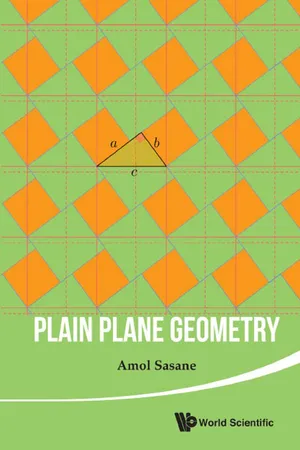Mathematics
Segment of a Circle
A segment of a circle is the region bounded by a chord and the arc it subtends. It is essentially a fraction of the entire circle, with the chord serving as the base and the arc as the curved side. The area of a segment can be calculated using the formula involving the radius and the central angle.
Written by Perlego with AI-assistance
Related key terms
2 Key excerpts on "Segment of a Circle"
- eBook - ePub
- Mark Ryan(Author)
- 2016(Publication Date)
- For Dummies(Publisher)
You can find the area of a segment. Not, of course, the area of a line segment (which has no area), but the area of a Segment of a Circle — a completely different sort of thing. A circle segment is a chunk of a circle surrounded by a chord and an arc. The other circle region you look at here is a sector — a piece of a circle surrounded by two radii and an arc. In this section, I show you how to find the area of each of these regions. So here are the definitions of the two regions (Figure 15-2 shows you both): Sector: A region bounded by two radii and an arc of a circle (plain English definition: the shape of a piece of pizza) Segment of a Circle: A region bounded by a chord and an arc of a circle © John Wiley & Sons, Inc. FIGURE 15-2: A pizza-slice sector and a Segment of a Circle. Just as an arc is part of a circle’s circumference, a sector is part of a circle’s area; therefore, computing the area of a sector works like the arc-length formula in the preceding section. Area of a sector: The area of a sector (such as sector in Figure 15-2) is equal to the area of the circle () times the fraction of the circle represented by the sector: Use this formula to find the area of sector ACB from Figure 15-1 : Because is of, the area of sector ACB is of the area of the circle (just like the length of is of the circle’s circumference). Area of a segment: To compute the area of a segment like the one in Figure 15-2, just subtract the area of the triangle from the area of the sector (by the way, there’s no. technical way to name segments, but let’s call this one circle segment XZ): You know how to compute the area of a sector. To get the triangle’s area, you draw an altitude that goes from the circle’s center to the chord that makes up the triangle’s base. This altitude then becomes a leg of a right triangle whose hypotenuse is a radius of the circle. You finish with right-triangle ideas such as the Pythagorean Theorem - eBook - ePub
- Amol Sasane(Author)
- 2015(Publication Date)
- WSPC(Publisher)
Chapter 5Circles
We had defined the terms circle, its center and its radius in Section 1.6 . In this chapter, we will study circles. We begin with some terminology. Recall that a circle C (O, r ) with center O and radius r > 0 is the set of points P in the plane such that OP = r . The set of points P in the plane such that OP < r is called the interior of the circle, while the set of points P for which OP > r is called the exterior of the circle. Circles having the same center are said to be concentric .A line segment joining any two points on the circle is called a chord .A diameter is a special type of chord: it is one which passes through the center of the circle. Clearly the length of any diameter of a circle of radius r is equal to 2r . A diameter divides the circle into two semicircles .Theorem 5.1 . The perpendicular from the center of a circle to a chord bisects the chord .Proof . Let OM be the perpendicular dropped from the center O of the circle C (O, r ) to its chord AB . In the right triangles ΔOAM and ΔOBM , we have OA = OB = r , and the side OM is common. By the RHS Congruency Rule, ΔOAM ≃ ΔOBM , giving AM = MB , as wanted.Theorem 5.2 . The line joining the center of a circle to the midpoint of a chord is perpendicular to the chord .Proof . Let M be the midpoint of the chord AB of the circle C (O, r ). In the two triangles ΔOAM and ΔOBM , we have OA = OB = r , the side OM is common, and AM = BM . By the SSS Congruency Rule, we have ΔOAM ≃ ΔOBM . Hence we obtain ∠OMA = ∠OMB , and being supplementary, they must each equal 90°.Corollary 5.1 . The perpendicular bisectors of two chords of a circle contain its center .We know that two distinct points determine a unique line passing through them. We can now ask:
Learn about this page
Index pages curate the most relevant extracts from our library of academic textbooks. They’ve been created using an in-house natural language model (NLM), each adding context and meaning to key research topics.

